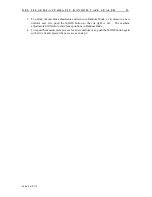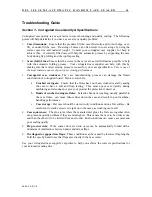
B E L 1 8 0 S E M I - A U T O M A T I C R A N D O M T A P E S E A L E R
14
Troubleshooting
Guide
Section 1 - Corrugated Case Quality & Specifications
Corrugated case quality is a major factor in smooth running and quality sealing. The following
points will help determine if you have a case size or quality problem:
1.
Case dimensions:
Ensure that the products fill the case efficiently and do not bulge, over-
fill, or under-fill the case. Re-sizing of cases can often result in cost savings by using the
correct case size and material weight. Consult your corrugated case supplier, for help to
achieve this. A correctly filled case will help the automatic process by supporting the case
body during flap folding and the top flap sealing.
2.
Score (fold) Lines:
Ensure that the scores in the cases are as well defined as possible to
help
with the automatic folding process. Your corrugated case supplier can help with this by
making sure that correct scoring pressure is used for your case specification.
This is one of
the most common causes of poor case- closing performance
3.
Corrugated case weakness:
The case manufacturing process can damage the fluted
construction of corrugated board. Points to watch for:
a.
Crushed corrugate:
Ensure that the flutes have not been crushed overall, causing
the case to have a soft and limp feeling. This causes poor case rigidity during
machining and also does not give your product the protection it deserves.
b.
Bands of crushed corrugate flutes:
Selective bands of crushing, usually parallel to
the case flutes, can cause failure lines down the case and result in poor machine-
handling performance.
c.
Case storage:
Flat cases should be stored in dry conditions and on a flat surface. Be
careful not to stack excessive weight on to the cases, as crushing can result.
4.
Case squareness:
The glue joint where the manufacturer glues the flat case together often
can present a quality problem if they are misaligned. This causes the case to be wider at one
end than the other or to be twisted from end to end. Both conditions can cause case jams and
poor sealing quality.
5.
Flap corner slots:
If the corner slots are wide, cases can be automatically folded with a
minimum of interference between major and minor flaps.
6.
Overlapped or gapped case flaps:
These conditions can be caused by
incorrect flap lengths.
Fold the case by hand to see that flaps meet neatly in the case center.
Use your corrugated case supplier’s expertise to help you achieve the correct specifications for
your automatic sealing line.
65-34-5 4/21/10


































